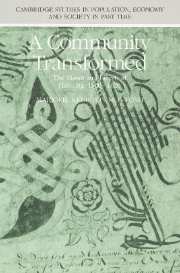Book contents
- Frontmatter
- Contents
- List of figures
- List of tables
- Acknowledgements
- Abbreviations
- Introduction
- 1 Life and death
- 2 Changing economic patterns
- 3 Religion
- 4 Facets of a society in transition
- 5 Havering's declining independence
- 6 Overt conflict, 1607–19
- Conclusion
- Appendices
- Bibliography
- Index
- Cambridge Studies in Population, Economy and Society in Past Time
3 - Religion
Published online by Cambridge University Press: 11 October 2009
- Frontmatter
- Contents
- List of figures
- List of tables
- Acknowledgements
- Abbreviations
- Introduction
- 1 Life and death
- 2 Changing economic patterns
- 3 Religion
- 4 Facets of a society in transition
- 5 Havering's declining independence
- 6 Overt conflict, 1607–19
- Conclusion
- Appendices
- Bibliography
- Index
- Cambridge Studies in Population, Economy and Society in Past Time
Summary
At the beginning of the sixteenth century, religion was a unifying force within Havering. The laity shared common views about doctrine and religious customs, and the local churches were the centres of religious activity and emotion. Office-holding in the parishes, the religious fraternities, and a chantry in Romford provided laymen with opportunities to exercise power over local religion. Most important, they were in a position to hire four priests to their own liking: one chosen by the churchwardens of Romford, two by the members of the fraternities, and one by the trustees of the chantry. Authority within Havering's churches was held by the same extended group of middling families – yeomen and prosperous craftsmen and traders – who dominated the Havering manor court. The official clergy named by New College, Oxford were relatively unimportant to the religious life of the community.
Over the course of the following century, religion became a more complex factor. Certain attitudes of the laity remained effectively unchanged. The strongest ongoing concern was a desire for lay participation, ideally for lay control, in the affairs of the parish and the selection of clergy. Although the laity lost their ability to hire clergy directly at the time of the Edwardian Reformation, the wealthiest families in Havering had gained the right by around 1590 to nominate ministers to New College, in return for supplementing their salaries. Another concern was an interest in clergymen who would hold services and preach.
- Type
- Chapter
- Information
- A Community TransformedThe Manor and Liberty of Havering-atte-Bower 1500–1620, pp. 176 - 258Publisher: Cambridge University PressPrint publication year: 1991

